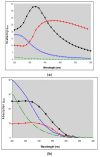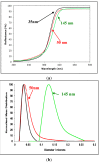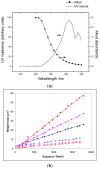UV-absorption--the primary process in photocatalysis and some practical consequences
- PMID: 25383755
- PMCID: PMC6270690
- DOI: 10.3390/molecules191118192
UV-absorption--the primary process in photocatalysis and some practical consequences
Abstract
TiO2 photochemistry studies generally address reactions of photogenerated charge-carriers at the oxide surface or the recombination reactions which control the proportion of charge carriers that reach the surface. By contrast, this review focuses on UV absorption, the first photochemical step in semiconductor photocatalysis. The influence of particle size on absorption and scattering of light by small TiO2 particles is summarized and the importance of considering, the particle size in the application, not the BET or X-ray line broadening size, is emphasized. Three different consequences of UV absorption are then considered. First, two commercially important systems, pigmented polymer films and paints, are used to show that TiO2 can protect from direct photochemical degradation. Then the effect of UV absorption on the measured photocatalytic degradation of aqueous solutions of organics is considered for two separate cases. Firstly, the consequences of UV absorption by TiO2 on the generation of hydroxyl radicals from H2O2 are considered in the context of the claimed synergy between H2O2 and TiO2. Secondly, the effect of altered UV absorption, caused by changed effective particle size of the catalyst, is demonstrated for photocatalysis of propan-2-ol oxidation and salicylic acid degradation.
Conflict of interest statement
The authors declare no conflict of interest.
Figures

















Similar articles
-
The photocatalytic degradation of dicamba in TiO2 suspensions with the help of hydrogen peroxide by different near UV irradiations.Water Res. 2004 Feb;38(4):1037-43. doi: 10.1016/j.watres.2003.10.037. Water Res. 2004. PMID: 14769424
-
UV and Visible Light-Driven Production of Hydroxyl Radicals by Reduced Forms of N, F, and P Codoped Titanium Dioxide.Molecules. 2019 Jun 6;24(11):2147. doi: 10.3390/molecules24112147. Molecules. 2019. PMID: 31174409 Free PMC article.
-
[Mechanism and kinetics of phenol degradation by TiO2 photocatalytic combined technologies].Huan Jing Ke Xue. 2013 Feb;34(2):596-603. Huan Jing Ke Xue. 2013. PMID: 23668128 Chinese.
-
Advanced oxidation processes: mechanistic aspects.Water Sci Technol. 2008;58(5):1015-21. doi: 10.2166/wst.2008.467. Water Sci Technol. 2008. PMID: 18824799 Review.
-
Recent advances in application of UV light-emitting diodes for degrading organic pollutants in water through advanced oxidation processes: A review.Water Res. 2018 Apr 1;132:177-189. doi: 10.1016/j.watres.2017.12.079. Epub 2018 Jan 4. Water Res. 2018. PMID: 29331640 Review.
Cited by
-
Broad-Spectrum Antimicrobial Effects of Photocatalysis Using Titanium Dioxide Nanoparticles Are Strongly Potentiated by Addition of Potassium Iodide.Antimicrob Agents Chemother. 2016 Aug 22;60(9):5445-53. doi: 10.1128/AAC.00980-16. Print 2016 Sep. Antimicrob Agents Chemother. 2016. PMID: 27381399 Free PMC article.
-
Synthesis of Uniform Size Rutile TiO2 Microrods by Simple Molten-Salt Method and Its Photoluminescence Activity.Nanomaterials (Basel). 2022 Jul 29;12(15):2626. doi: 10.3390/nano12152626. Nanomaterials (Basel). 2022. PMID: 35957057 Free PMC article.
-
A Novel High-Energy Vacuum Ultraviolet Light Photofunctionalization Approach for Decomposing Organic Molecules around Titanium.Int J Mol Sci. 2023 Jan 19;24(3):1978. doi: 10.3390/ijms24031978. Int J Mol Sci. 2023. PMID: 36768297 Free PMC article.
-
Concentration Quantification of TiO2 Nanoparticles Synthesized by Laser Ablation of a Ti Target in Water.Materials (Basel). 2022 Apr 26;15(9):3146. doi: 10.3390/ma15093146. Materials (Basel). 2022. PMID: 35591479 Free PMC article.
-
Evaluation on the Photosensitivity of 2,2'-Azobis(2,4-Dimethyl)Valeronitrile with UV.Molecules. 2017 Dec 14;22(12):2219. doi: 10.3390/molecules22122219. Molecules. 2017. PMID: 29240680 Free PMC article.
References
-
- Matsunaga T., Okochi M. TiO2-Mediated Photochemical Disinfection of Escherichia coli Using Optical Fibers. Environ. Sci. Technol. 1995;29:501–505. - PubMed
-
- Maillard C., Guillard C., Pichat P. Comparative effects of the TiO2-UV, H2O2-UV H2O2-Fe2+ systems on The disappearance Rate of benzamide and 4-hydroxybenzamide in water. Chemosphere. 1992;24:1085–1094.
-
- Mills A., Belghazi A., Davies R.H., Morris S.A. Kinetic study of the bleaching of Rhodamine 6G photosensitized by titanium dioxide. J. Photochem. Photobiol. A. 1994;79:131–139.
-
- Fateh R., Dillert R., Bahnemann D. Self-cleaning properties, mechanical stability, and adhesion strength of transparent photocatalytic TiO2-ZnO coatings on polycarbonate. ACS Appl. Mater. Interfaces. 2014;6:2269–2277. - PubMed
-
- Hughes W. Xth FATIPEC Congress 1970. Verlag Chemie GmbH; Weinheim/Bergst, Germany: 1970. Phodegradation of paint films containing TiO2 pigments; pp. 67–82.
Publication types
MeSH terms
Substances
LinkOut - more resources
Full Text Sources
Other Literature Sources

